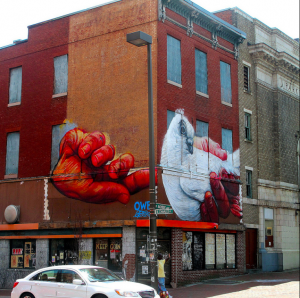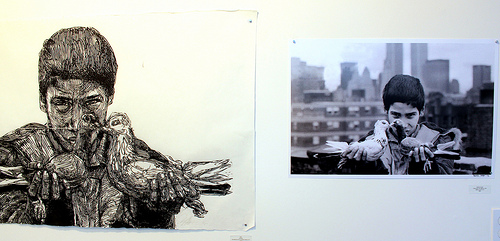The word “Gaia” refers to the Greek deity representing the earth, and how it functions as a whole. Since the 1970s, the mythology has also spurred the Gaia hypothesis, in which the earth is seen as a living organism whose different parts act as interdependent ecosystems. In 2007, a Baltimore-based street artist adopted the name for his art, which leans heavily on naturalistic scenes and socio-political critiques projected on buildings in murals or large-scale prints.
One of Gaia’s early trademarks were black and white drawings of animals or people’s faces outlined with a thick border, floating over a background of collaged graffiti. Since then, his style has evolved to focus on colorful, large-scale murals. His work appears all over the world, including Rome, Seoul, Buenos Aires, and Amsterdam.
 Gaia grew up in New York but now lives in Baltimore. He first started gaining serious recognition in 2008, when The New York Times featured his New York work in its travel section. His first major exhibition was at The Irvine Contemporary in Washington, D.C., in 2010. Last year, in Italy, the Palazzo Collicola gallery in Spoleto set up a permanent installation of his wall paintings of African immigrants and religious relics of the region of Umbria.
Gaia grew up in New York but now lives in Baltimore. He first started gaining serious recognition in 2008, when The New York Times featured his New York work in its travel section. His first major exhibition was at The Irvine Contemporary in Washington, D.C., in 2010. Last year, in Italy, the Palazzo Collicola gallery in Spoleto set up a permanent installation of his wall paintings of African immigrants and religious relics of the region of Umbria.
Gaia’s progression as an artist takes a cue from the way cities change over time.
“I was taking posters and wrapping them around doors and windows and whatnot, just sort of psycho-geographically navigating [the] city, and stamping these prints and then putting them up,” Gaia told the Free Press.
He began to detect a history behind each city that was not superficially visible.
“I became interested in ‘why is this building upending?’ ‘Why is this street a one-way street?’ So I slowly moved toward a more site-generated approach where I was doing research and responding by creating work,” he said.
“You walk through Bushwick and you go down Morgan Avenue and you’ll find Newtown Creek, which is totally polluted and whatnot, but it is its own strange, perverse nature,” Gaia said.
His murals in Bushwick and Williamsburg juxtapose images of nature with industry and commerce.
“I think it makes perfect sense to incorporate nature into this concrete jungle and create an albeit artificial, painted, and non-three dimensional environment,” said David Meade, a Street Art Walk guide touring hotbeds of street art in Bushwick and Williamsburg. “But it is still at least a reference to earth and nature.”
Part-time New School faculty member Philip Silva teaches Urban Ecology, a field that examines the ecosystems — whether natural or economic — that are inherent in cities.
“100 years ago,” Silva told The Free Press, “we were all pretty much on the same page telling a story about nature, about an endless source of resources for us to control and plunder. That was sort of the dominant nature story at the time.”
Since then, other stories have emerged, Silva says, ones that are more specific and relevant to our current place in history. As evident in the work of Gaia and many other street artists, another narrative has emerged of late, which is a critique of the antiquated story of endless natural resources, and how delusional it appears when told in 2014.
Linus is a Literary Studies major at Lang. He enjoys seeing dope music shows and cooking dope ass meals in his spare time. He hails from Seattle, WA and left there to get away from the perpetual grey weather and become a full time New Yorker instead. He plans to write fiction as a career (knock on wood) and travel a lot.









Thank you, I have just been searching for information approximately this topic for
a while and yours is the best I have found out till now.
But, what concerning the conclusion? Are you positive concerning the
source?
I think the admin of this web page is in fact working hard in support of his site, because here
every information is quality based data.
Highly energetic article, I loved that a lot.
Will there be a part 2?